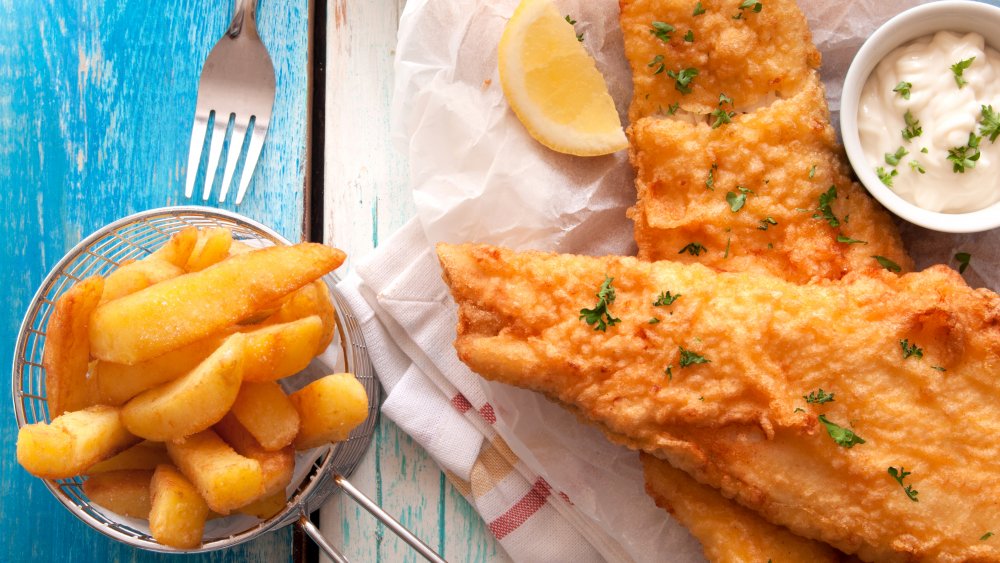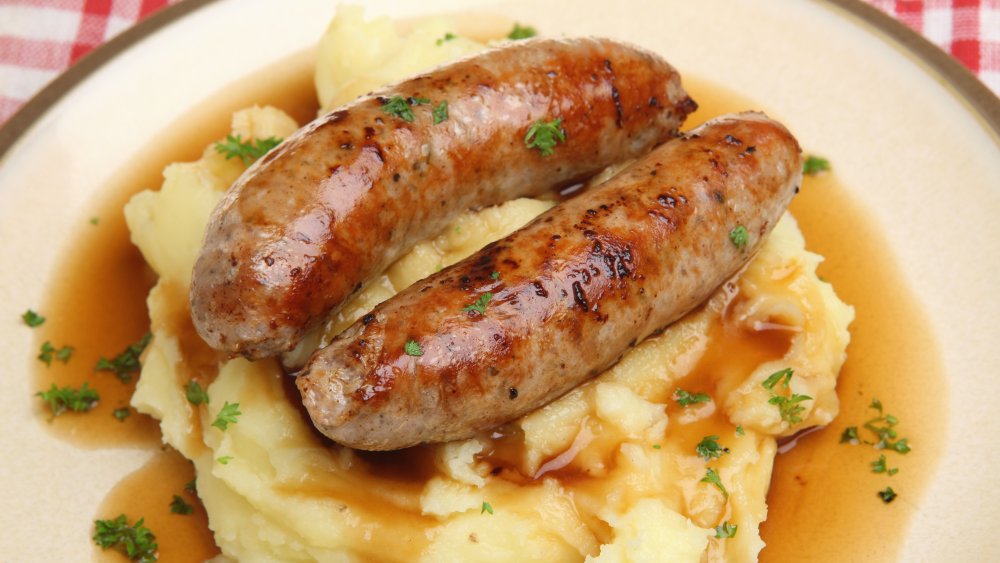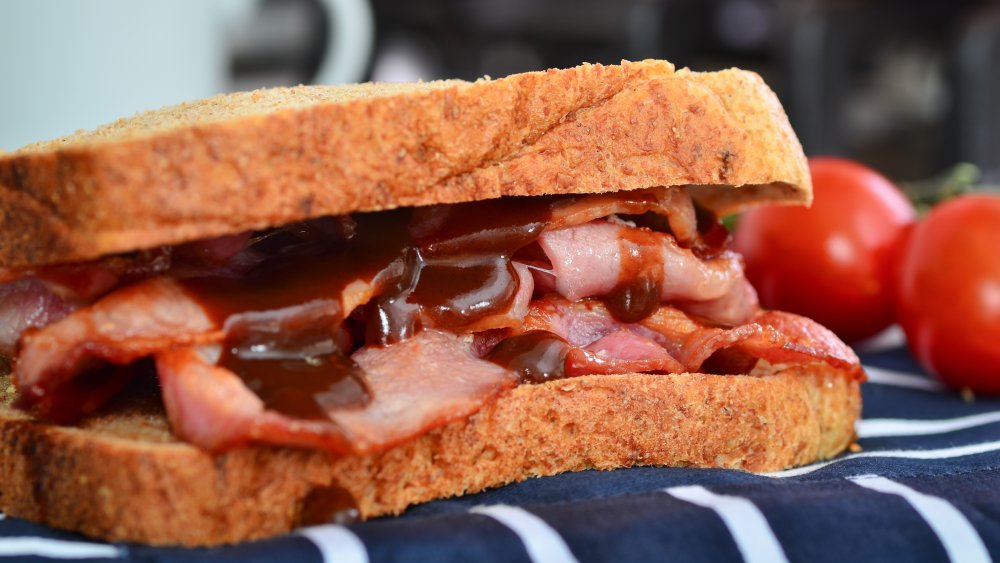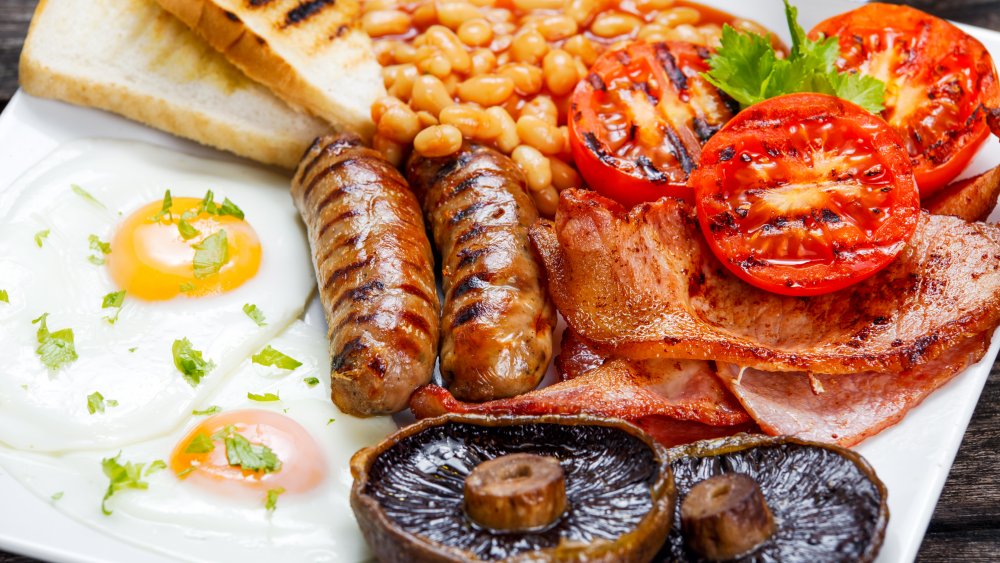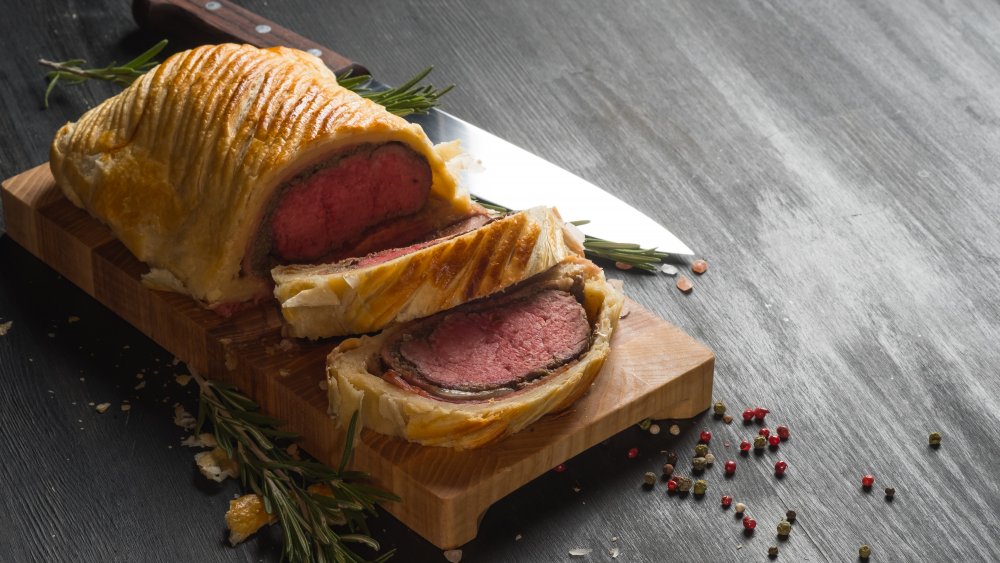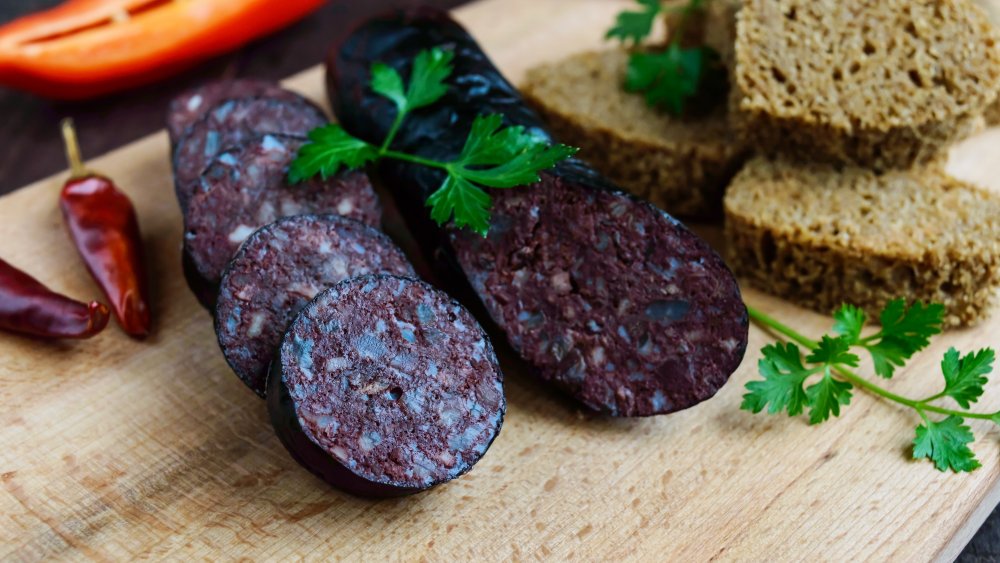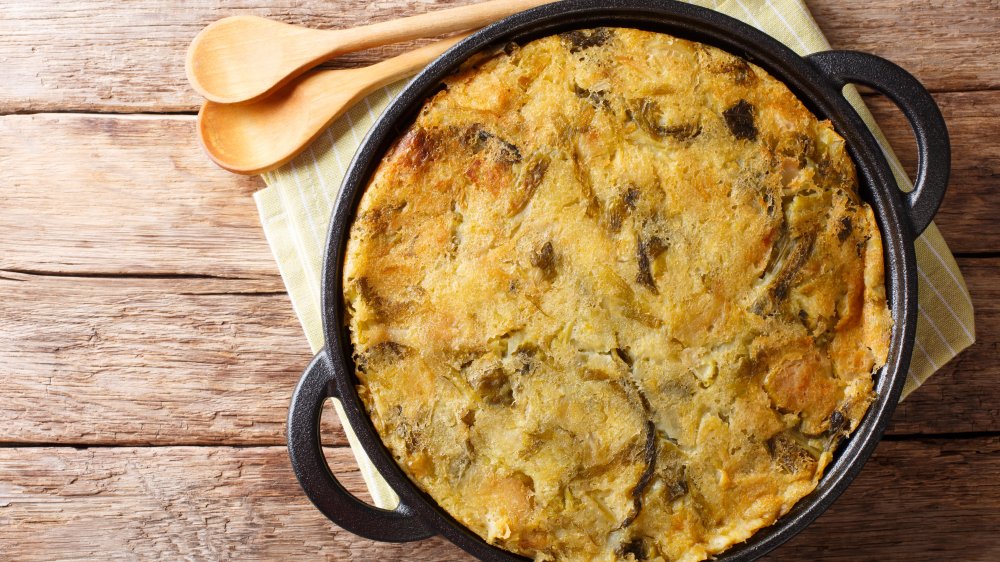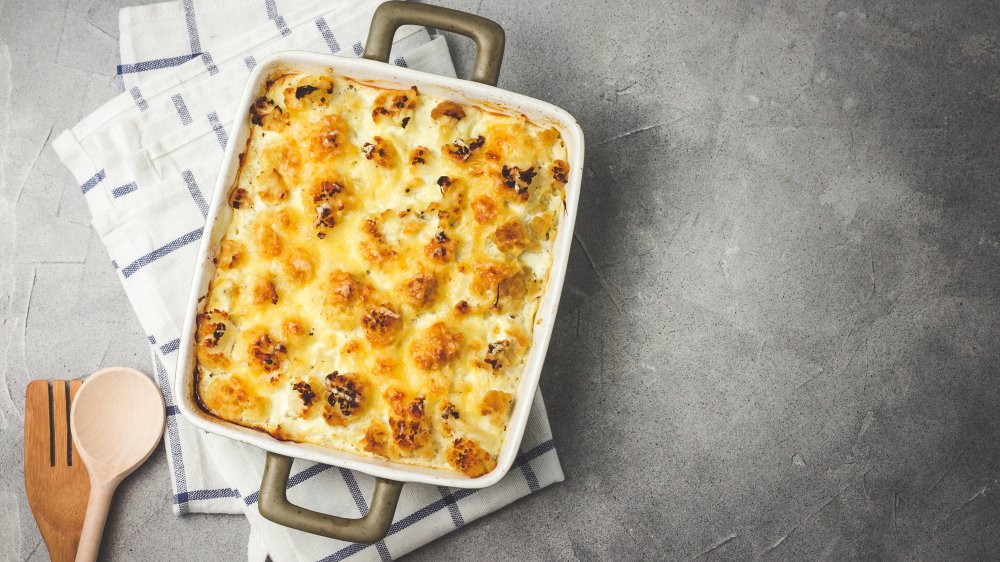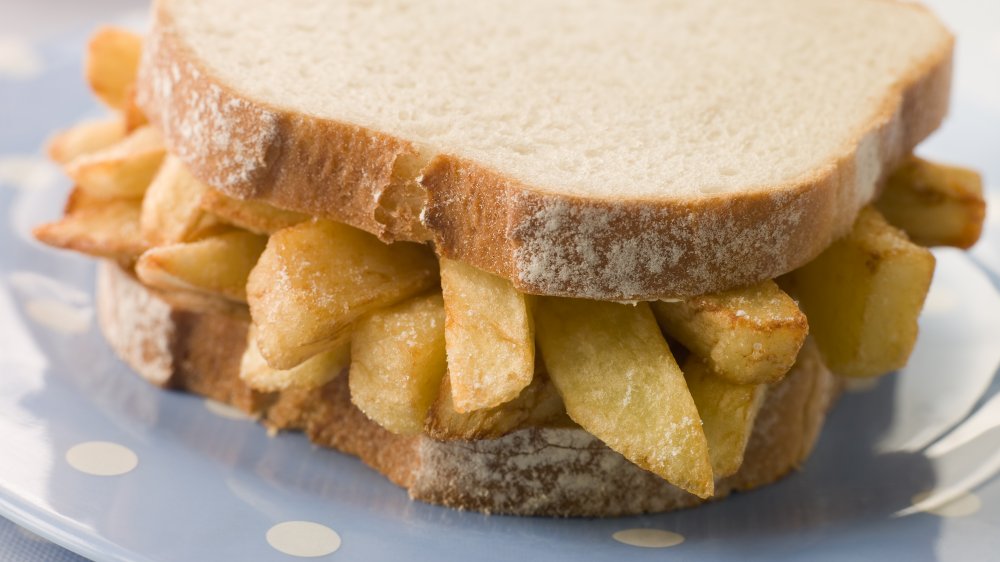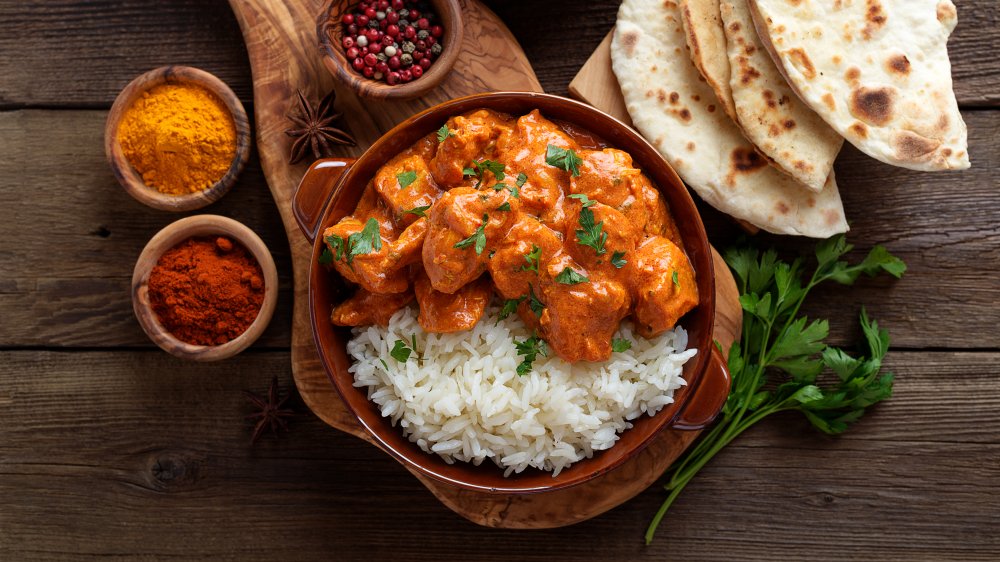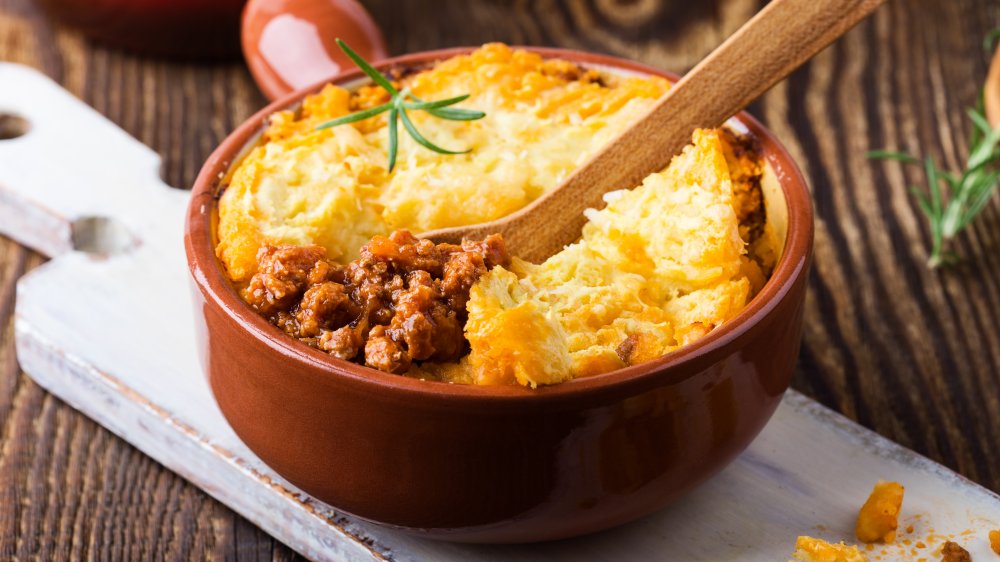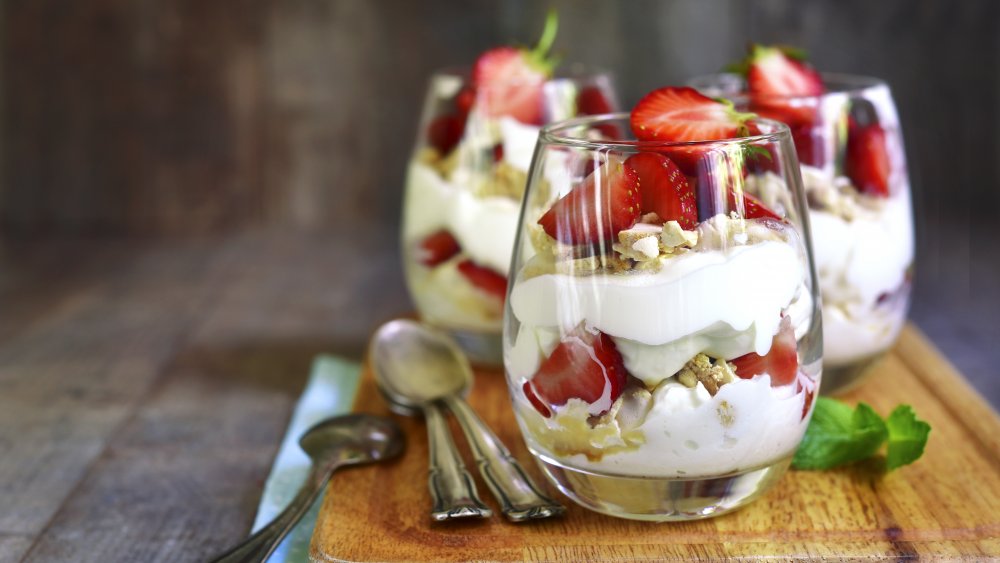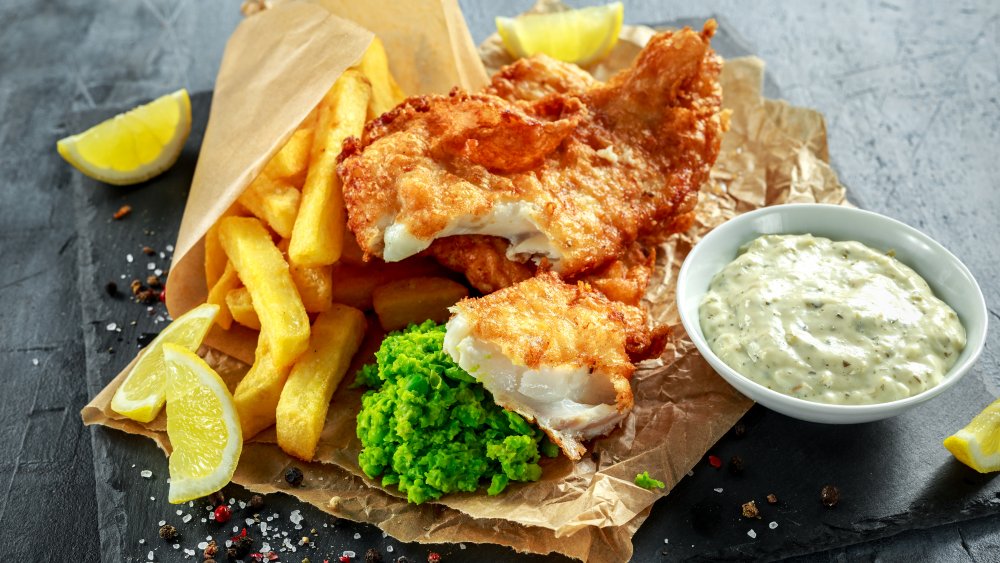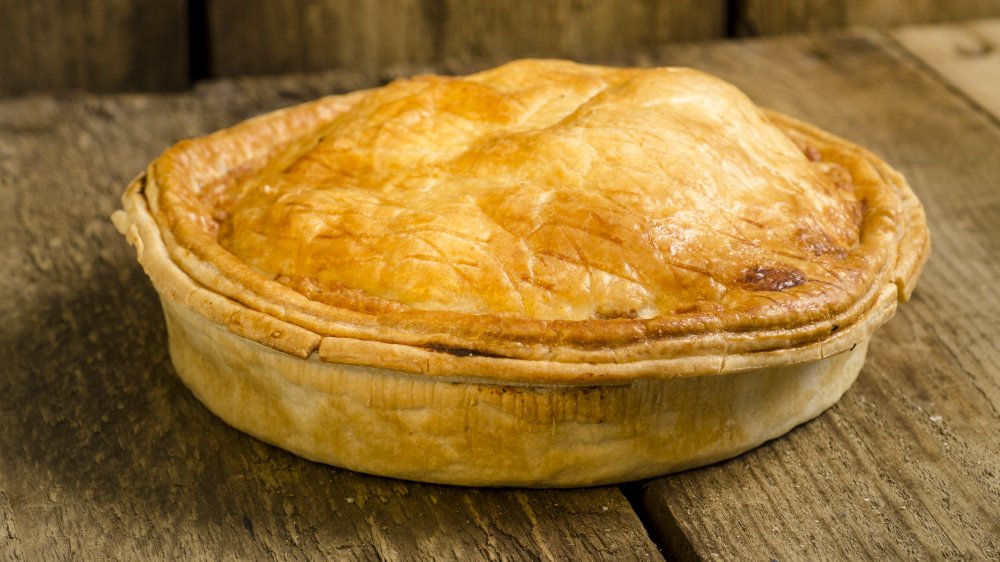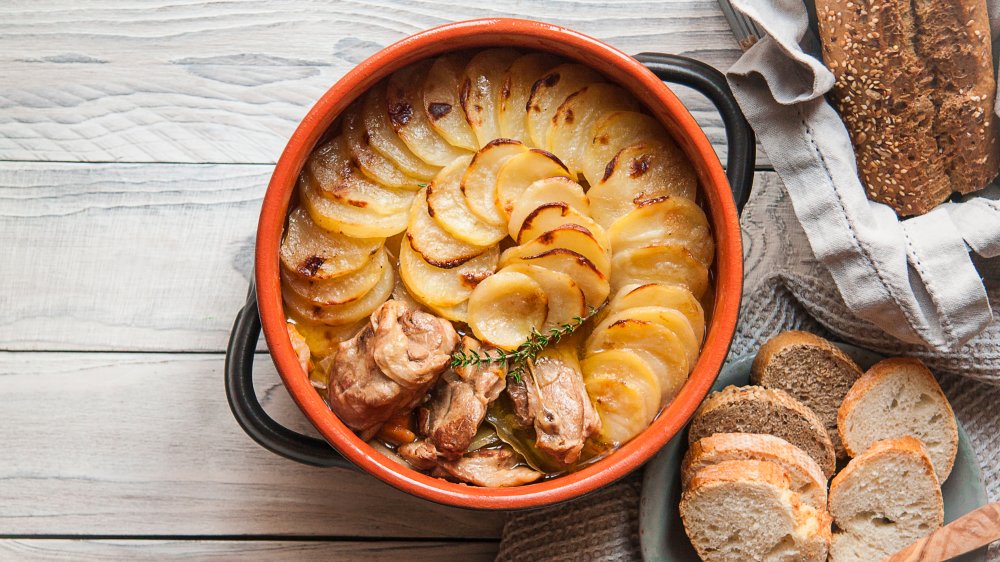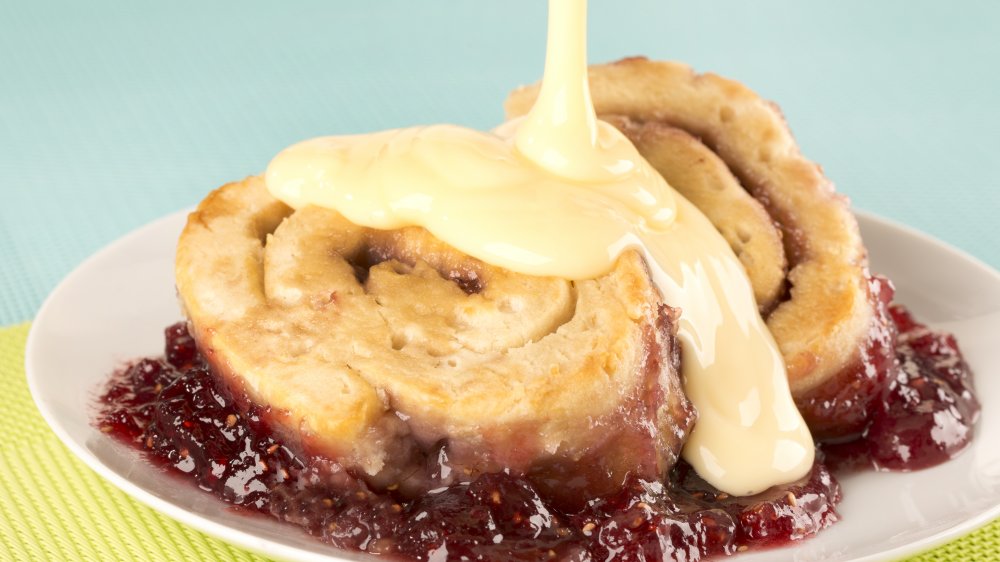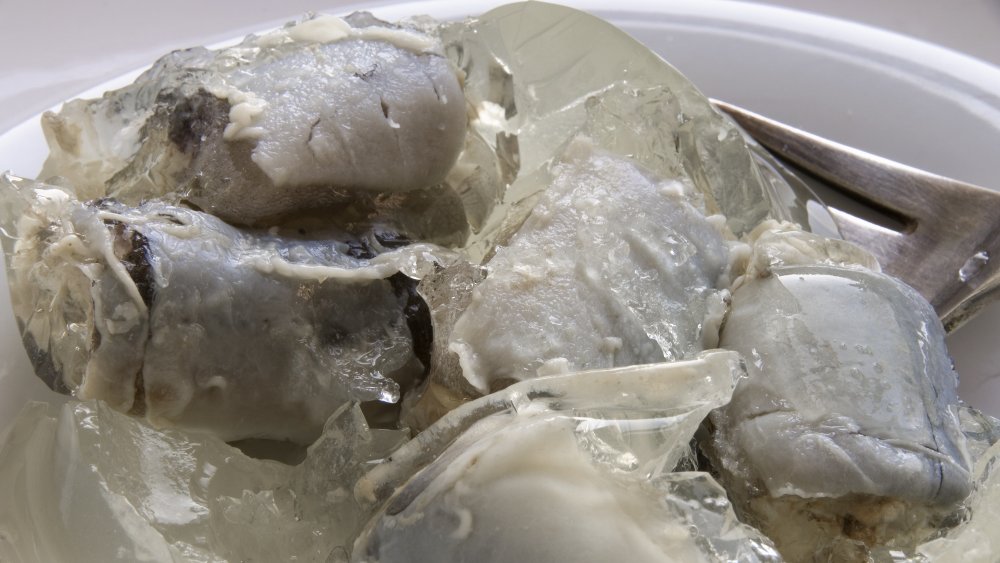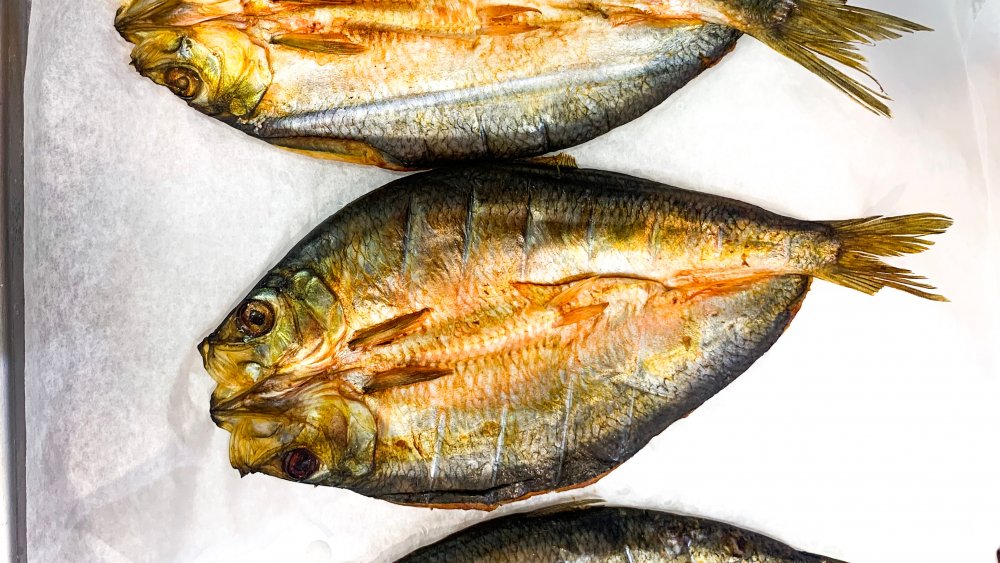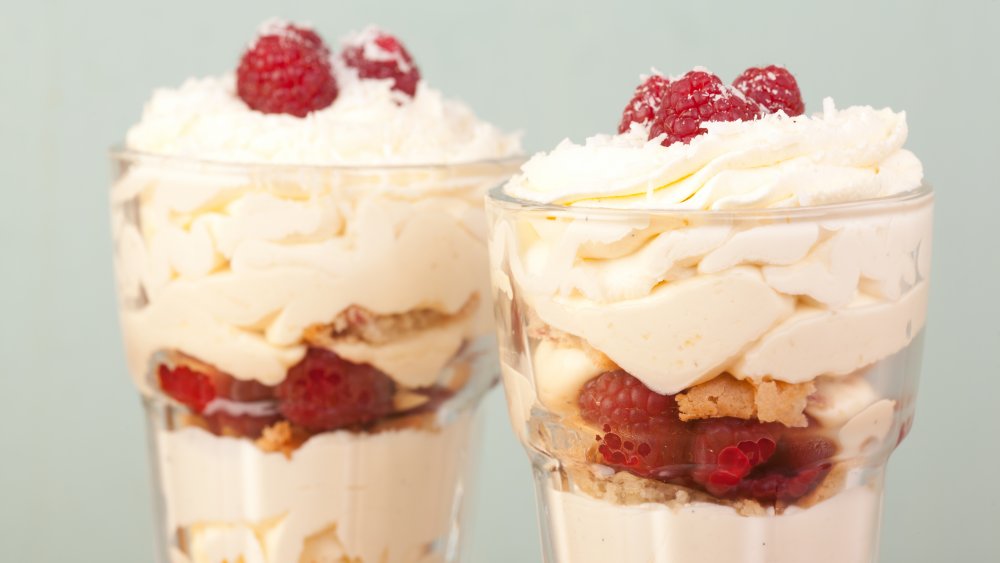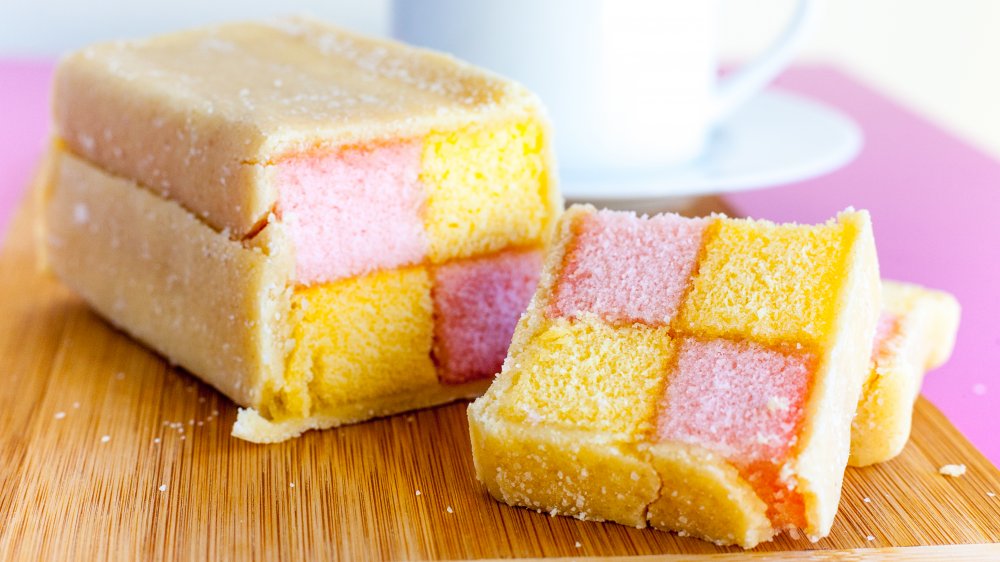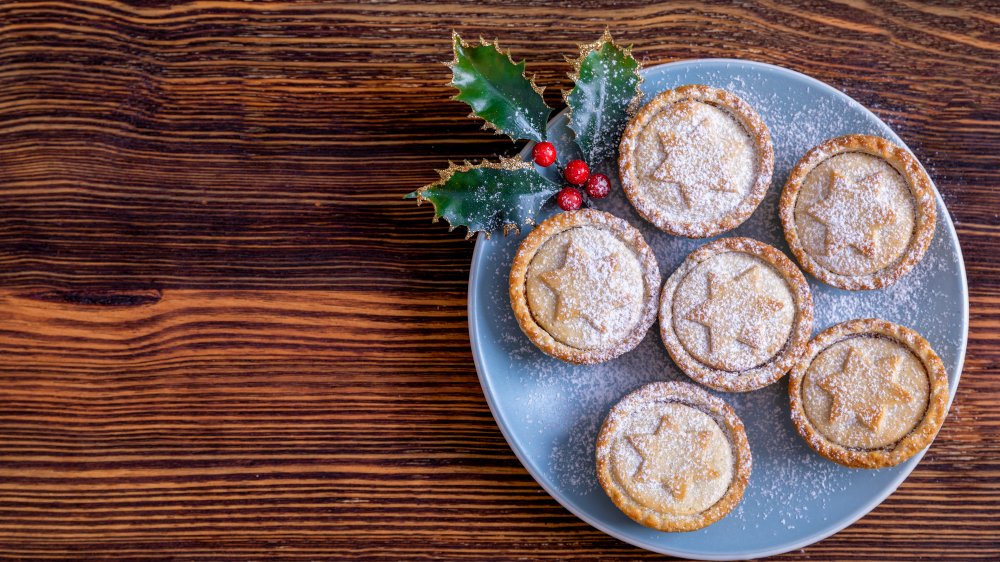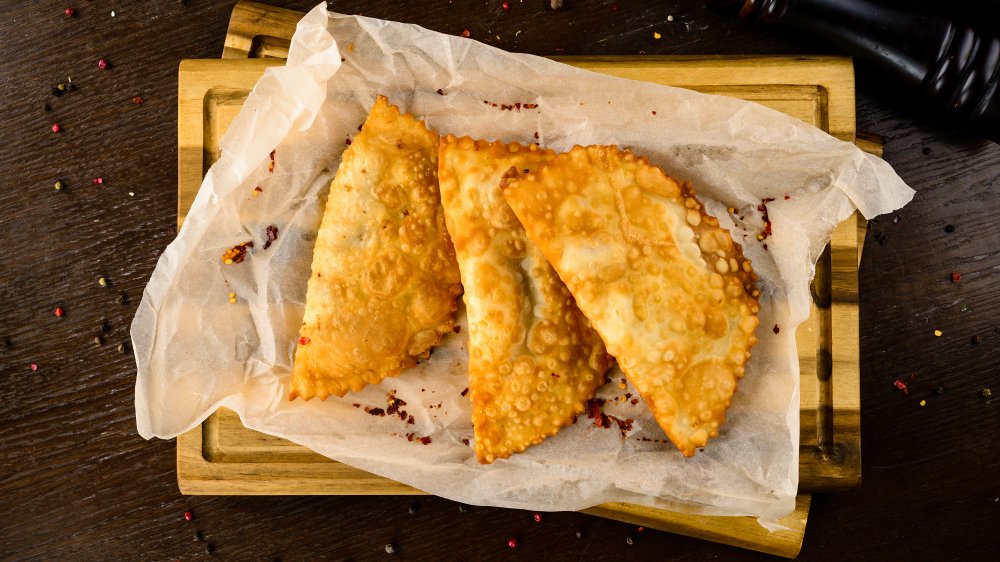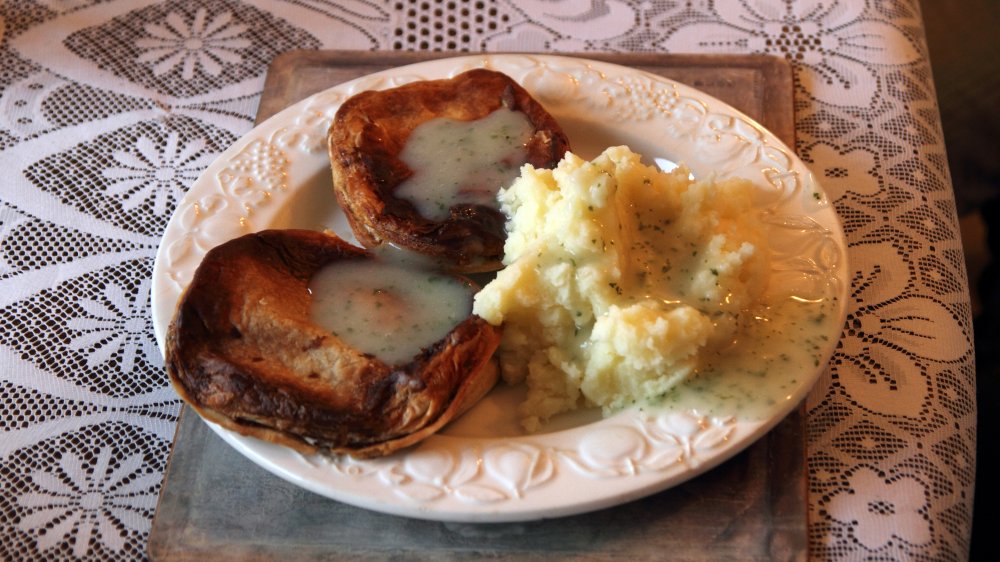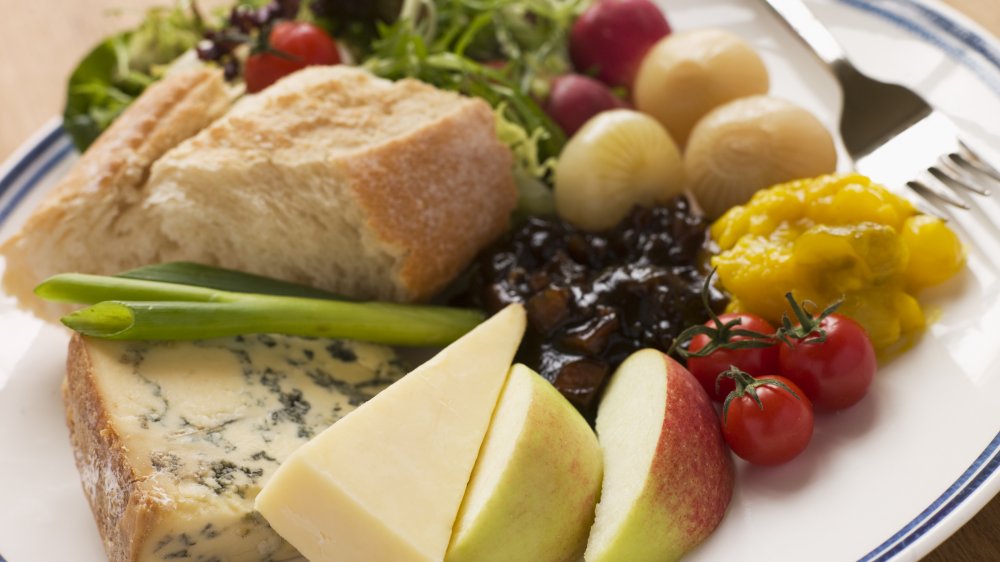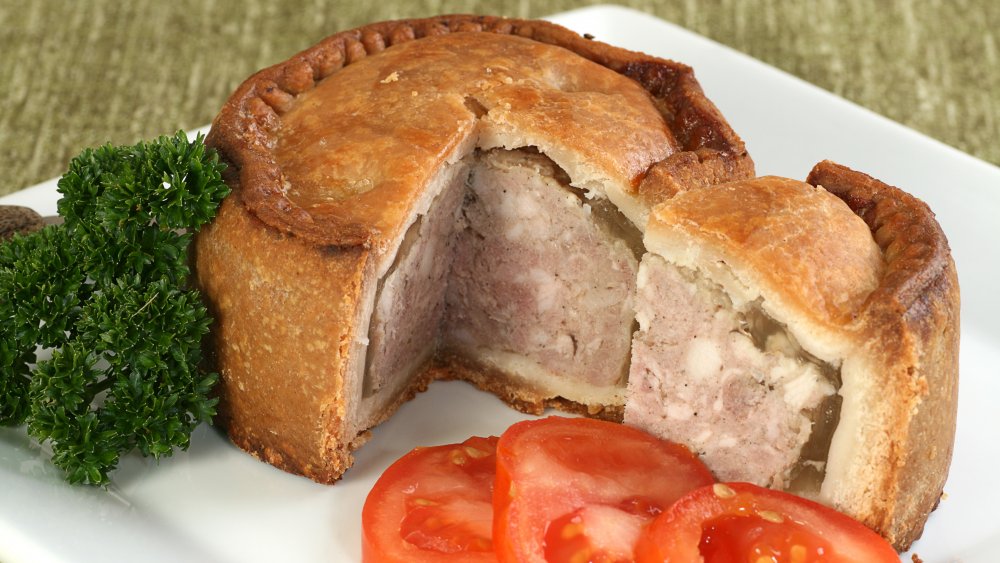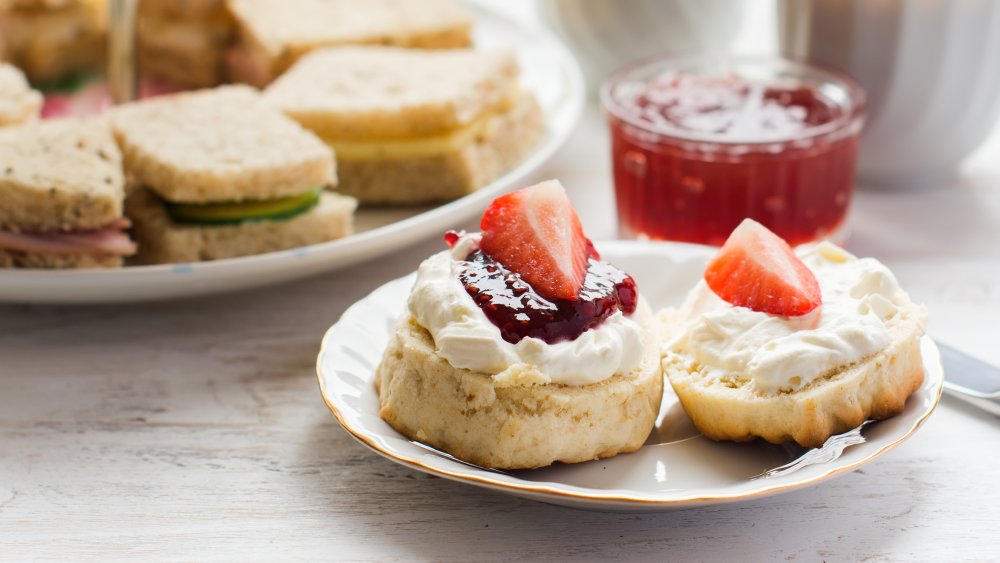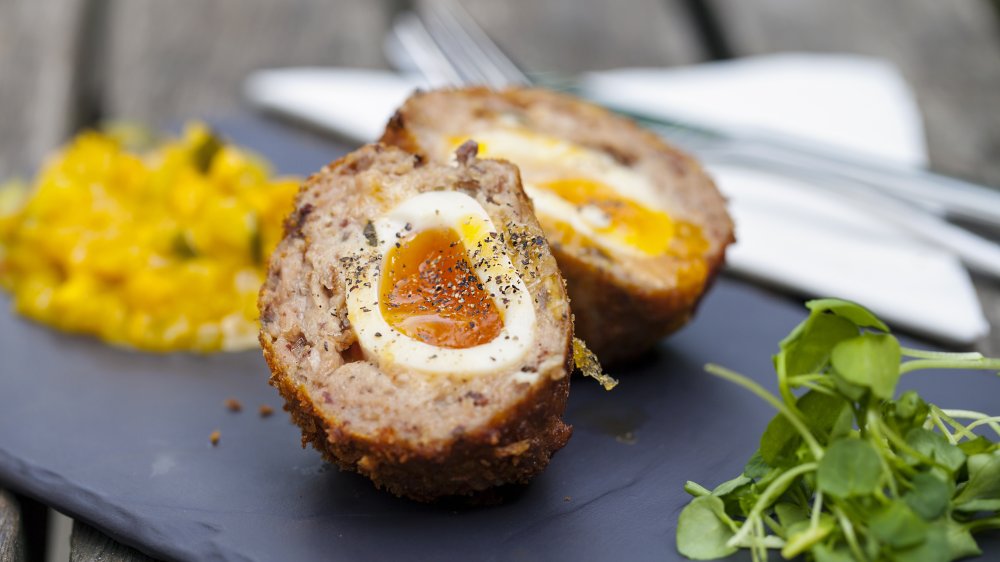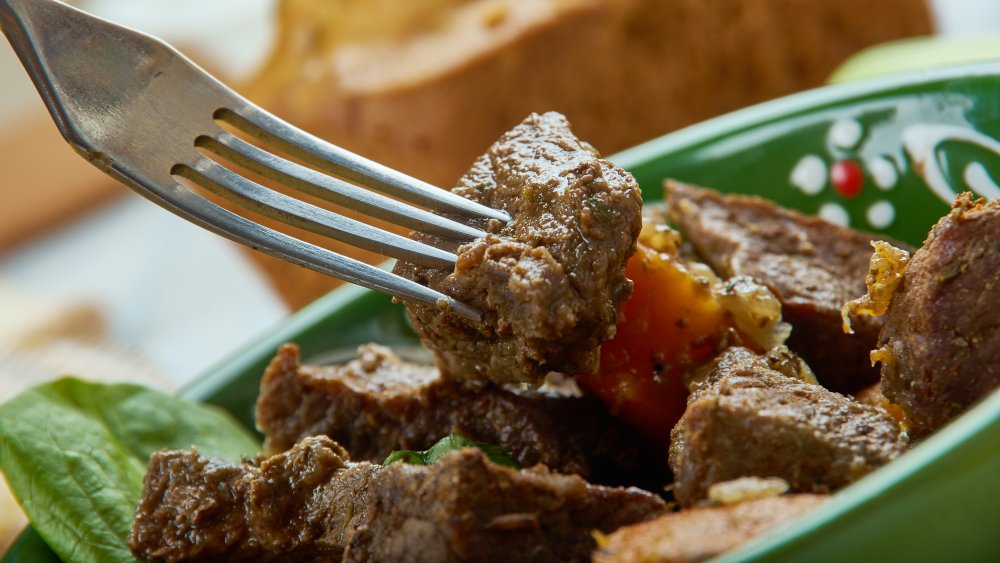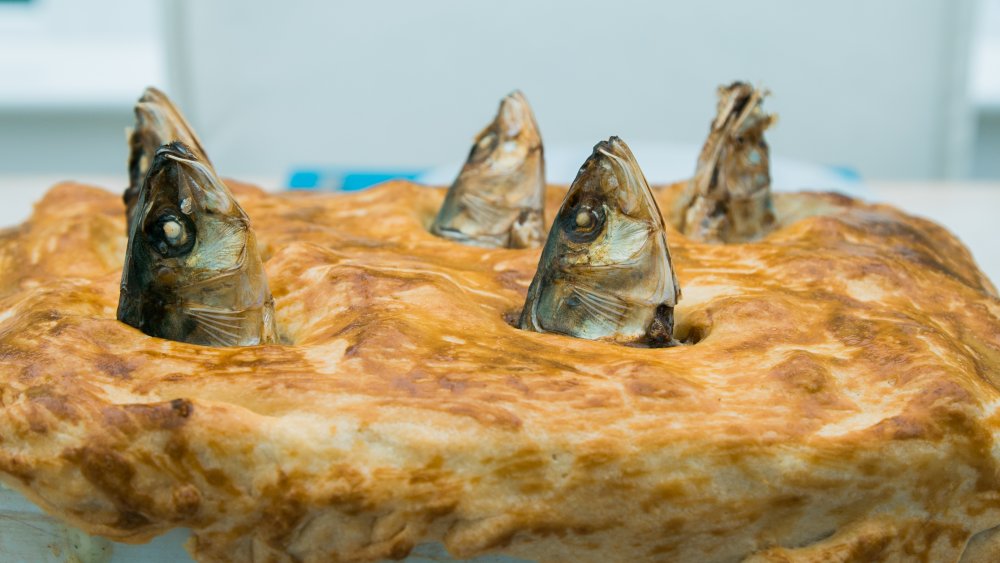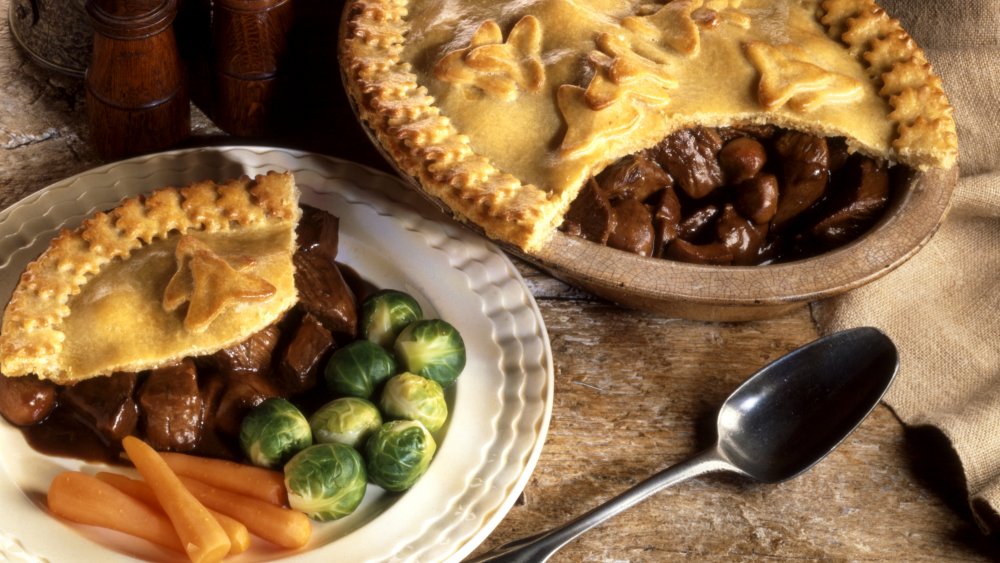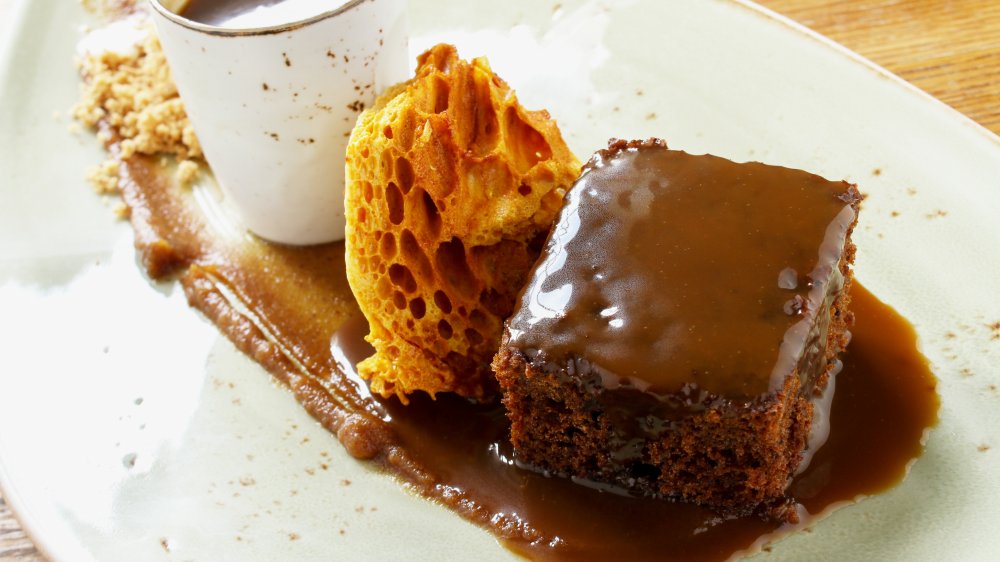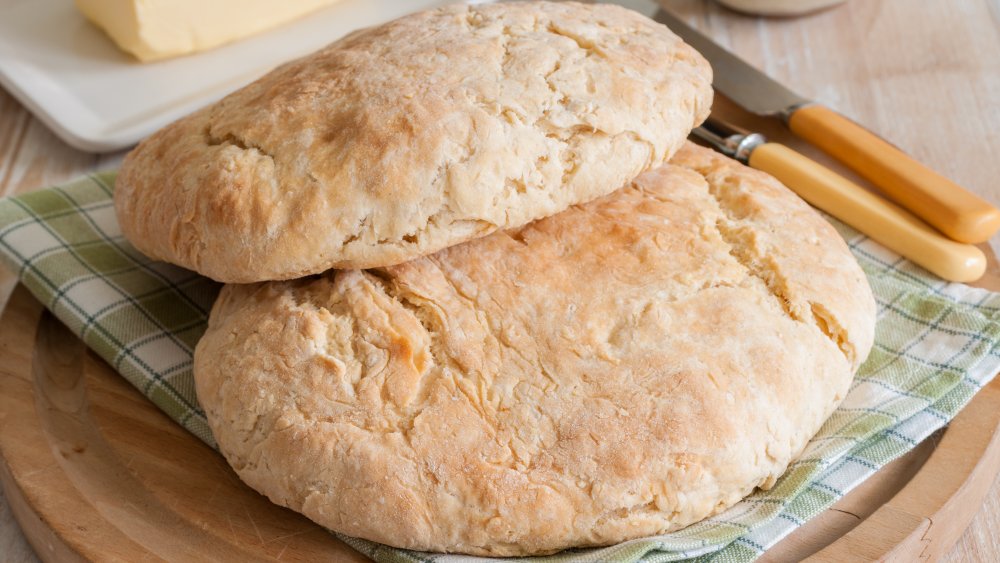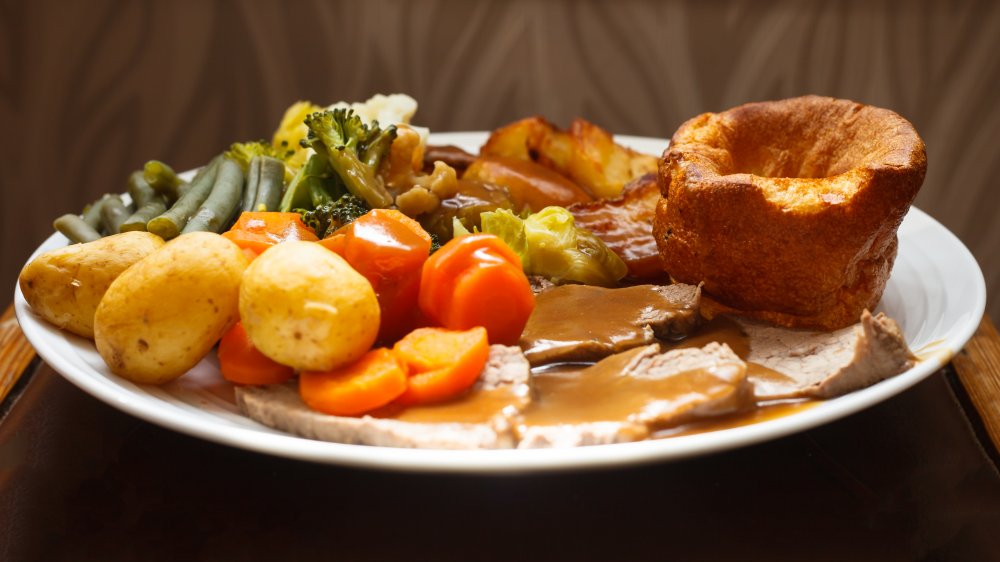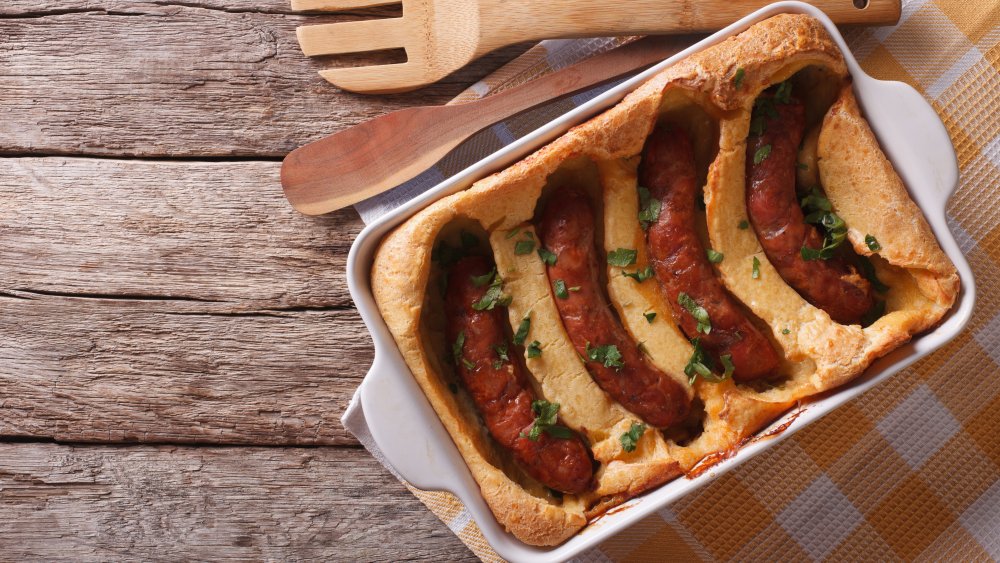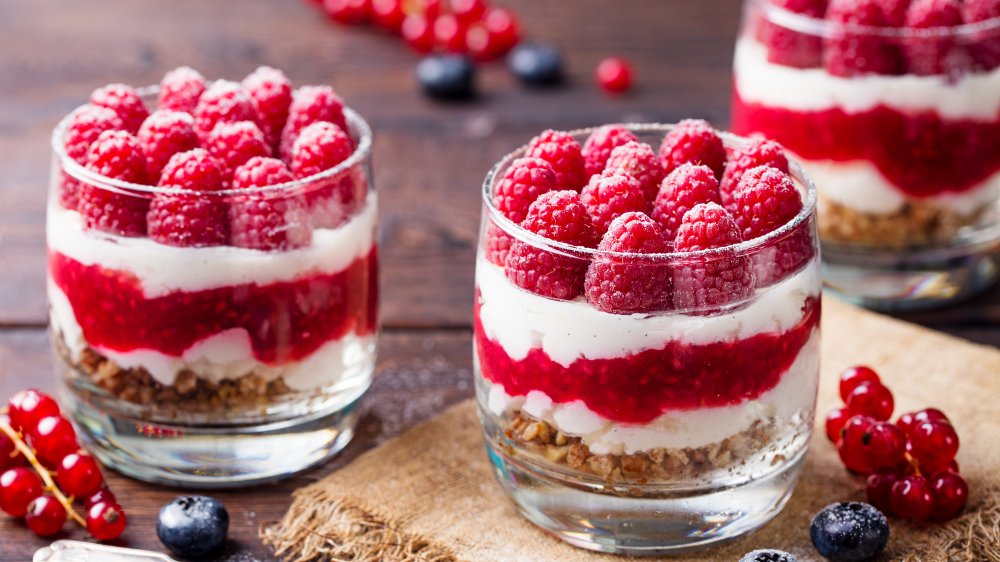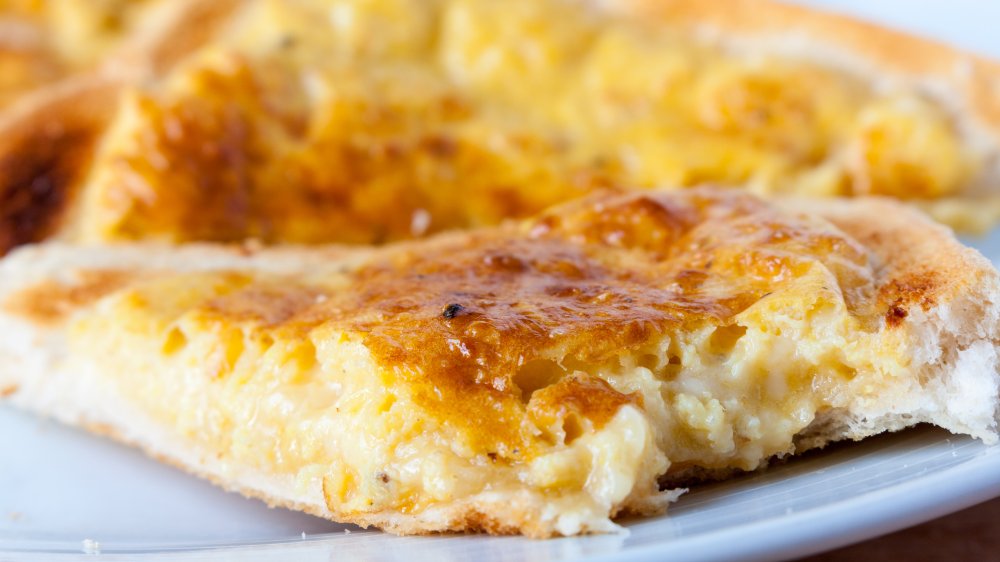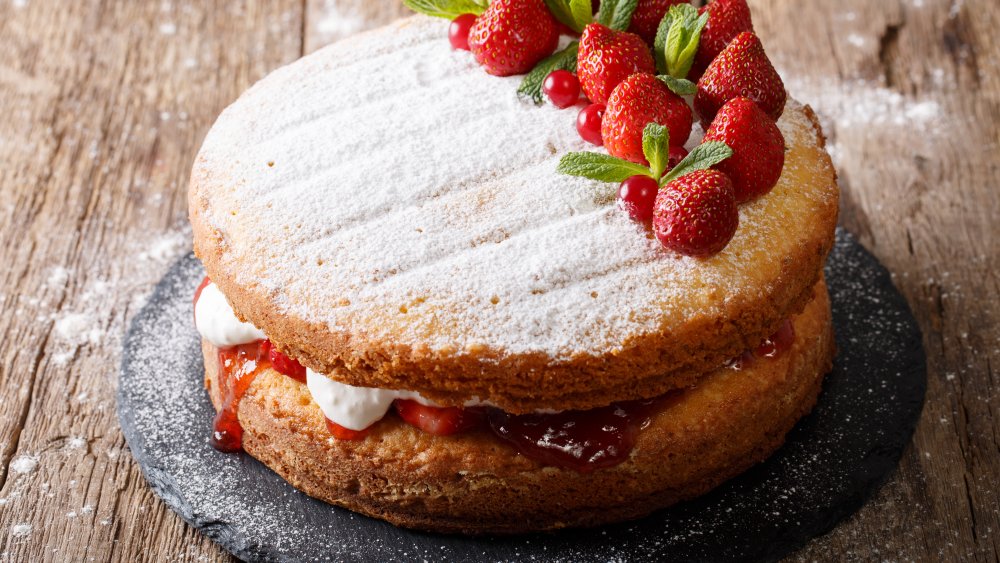British Foods You Need To Try Before You Die
Alright, let's face facts here. British food has never exactly enjoyed a stellar reputation, especially in the shadow of the country's continental neighbours. After all, who needs kippers and pasties when you've got pizza? Or paella? Or ratatouille? Or, you know... literally anything else?
But don't swear off British grub just yet, because this reputation is totally undeserved. Sure, the U.K.'s culinary tradition may not be as flash or as fancy as the stuff you'll find elsewhere in Europe, but that doesn't mean there's not a whole lot to enjoy here. The truth is, British food has a hell of a lot going for it. It's hearty, affordable, easy to make, and most of the time — not all, but most — it's pretty damn tasty, too. So throw away those suppositions, forget what you've heard about British cuisine, and give these iconic national dishes a try. Trust us: you won't regret it.
Bangers and mash
Bring bangers and mash down to its essence and you won't find many dishes simpler than this. It consists of a handful of sausages (or one Cumberland sausage, if you're particularly hungry) and a big ol' dollop of mashed potatoes. More often than not, gravy will be involved. And that's it!
Usually, of course, things turn up a little fancier than that. The sausages can be made from lamb or beef rather than the standard pork, the mash can be spruced up with cream or mustard, while a handful of extra side additions (such as peas, greens, or fried onions) might be included, depending entirely on the preference of the person making it. Top tip: this one is best served with a pint.
Bacon sandwich
The first thing to know here is that British bacon isn't the same as American bacon. The British variant is leaner and meatier than the U.S. version, since it comes from the loin of the pig rather than the belly. We don't want to go stoking any international tensions here, but it's also fairly safe to say that the British stuff is far tastier, too.
That's why, in the U.K., it seems less crazy to stick a few rashers of bacon between two buttered slices of bread, slather it in ketchup (or brown sauce), and just go to town on it. The bacon sandwich — or "butty," as northerners call it — is the ultimate quick-fix breakfast. Some people like to spruce them up with fancy breads or fried eggs, but these people are wrong to do so. Bacon. Bread. Sauce. It's all you'll ever need.
Full English
The full English is probably the most well-known breakfast in the U.K. Although people make slight alterations to the dish based on their own preferences, a proper full English should include at least some combination of sausages, bacon, eggs (fried, poached, or scrambled; doesn't matter), tomatoes, mushrooms, toast, baked beans, and black pudding. Other regions in the U.K. have their own variations. In Scotland, for example, a full breakfast might include haggis or oatcakes, while in Wales you might find cockles or laverbread.
Although many hotels and B&Bs will offer a full English, the best ones tend to be served in grubby little greasy spoons, and should cost no more than a fiver. Forget the fancy stuff — that's the right way to do it.
Beef Wellington
One of the many pies and pastries to be found in British cuisine, Beef Wellington is made up of fillet steak coated with pâté and duxelles (which is a kind of mix of mushrooms, onions, and herbs), wrapped in ham and baked in a pastry. Many recipes use pâté de foie gras, but come on — you're better than that.
This is another one of those delectably hearty dishes that you'll most often find served in pubs up and down the U.K, though it's not too hard to make at home. If nothing else, it's a great use of leftovers.
Black pudding
One of Britain's more readily derided foods, black pudding is a kind of blood sausage made from pork blood, fat, and cereal (think oatmeal or something similar), and spiced with mint, thyme, and pennyroyal.
Taste-wise, imagine eating a particularly bready kind of sausage and you're probably halfway there. Although it's a regional speciality in the West Midlands and North-West of England, black pudding is a staple part of the full English, so you can expect to find it on breakfast tables around the country. And honestly, it tastes far better than it ought to.
Bubble and squeak
Aside from being one of the world's weirdest food names, bubble and squeak (also known as rumbledethumps in Scotland, which... okay) is a British breakfast food made up of pan-fried leftover vegetables. The primary ingredients tend to be mashed potatoes and cabbage, but you can throw pretty much anything else into the pan and it'll still turn out tasty as anything. It's best eaten with the other leftovers from a roast or as part of a full English, but this is a fairly versatile dish — and it's always fun to experiment.
Cauliflower cheese
Cauliflower cheese is pretty much exactly what it sounds like: boiled cauliflower covered in a cheese sauce (usually made from mature cheese, with cheddar being by far the most popular choice). Some recipes call for more complex sauces, utilizing such ingredients as mustard, nutmeg, Parmesan, breadcrumbs, or herbs, but there's no need to go overboard with this one. Cauliflower cheese works best as a delicious yet largely unassuming side dish to a more substantial main course — and there's really no need for it to steal the show. For this reason, you'll most likely find it acting as part of a roast dinner; albeit an integral one to many people.
Chip butty
It'd be very easy to give the chip butty a bad rap, but it wouldn't be fair in the slightest — because this is by far one of the best comfort foods Britain has to offer. The idea is as simple as anything: you heap a load of chips (chips, not fries) onto a slice of buttered bread, throw a little sauce on if you like (ketchup, brown sauce, or vinegar tend to be most popular), then stick another slice of bread on top... and you're good to go.
Most often found in the North of England — and usually sold out of burger vans — the chip butty is a mainstay food of the British working class. Depending on where you are in the country, and on what kind of bread you're using, you might hear it referred to as a chip sandwich, chip roll, chip bap, chip cob, chip sarnie, or something equally off the wall. Doesn't matter what it's called, though. They're all fab.
Chicken tikka masala
At first glance, chicken tikka masala may seem like an Indian dish — but it's generally accepted among most British people that it was actually created by South Asian immigrants in the United Kingdom (with one account placing its origins in Glasgow). This is disputed, though, and some claim it is simply a modification of an existing Indian recipe.
Either way, chicken tikka masala is one of the country's most iconic and best-loved dishes. It consists of small pieces of chicken that have been marinated in spices and yogurt before being oven-roasted, and then stirred into a tomato-based curry sauce. It's usually served with rice and naan, and is served in pretty much every single one of the U.K.'s many, many, many Indian restaurants and takeaways.
Cottage pie
Cottage pie is a hearty dinner recipe that consists of ground meat, such as beef or lamb, cooked in an onion gravy, topped with mashed potatoes, and baked. Often, you'll find other ingredients underneath that mash, such as peas or carrots — and if not then you'll find them on the side.
Many British people will remember cottage pie as a staple school dinner, which isn't an experience likely to elicit many fond memories. You can also find it on the menu in many pubs, of course... but anyone will tell you that the best cottage pie is a homemade cottage pie.
Eton mess
Named for the ultra-posh school from which it first originated, Eton mess is a wonderfully-English traditional dessert made up of strawberries, meringue, and whipped cream. Some recipes include other fruits such as raspberries and blackberries, but as long as you've got something fruity to play off against that cream — and the gorgeous, crumbly texture of the meringue — you'll be just fine. Best enjoyed in summer, obviously.
Fish and chips
Fish and chips is one of the most famous British dishes, and for good reason, too. In case you've never had it, it's basically fish fried in batter served up with the chunkiest, loveliest chips you can possibly imagine, usually doused in salt and vinegar — with a little ketchup or some mushy peas on the side. The fish itself is most often cod or haddock, but other types are occasionally used.
Although you'll find fish and chips pretty much everywhere in the U.K., proper seaside chippies (or chip shops) are by far your best bet. The fish is always freshly-caught, the chips are just right and the setting — with many chippies sitting right on the seafront — is usually nothing less than gorgeous. Put short: this is the ultimate British culinary experience.
Game pie
Game pies are traditional English pastries, originating in the ancient era, best known for becoming really rather over-the-top elaborate during the Victorian period. Although recipes for game pies have changed over the years, modern variations tend to contain meats such as venison, rabbit, pheasant, pigeon, or boar, and are mixed in with garlic, shallots or onions, bacon, pork, and a range of different herbs and spices.
Unlike the Victorians, you needn't worry about birds stuffed within birds or crazy, fancy pastry patterns — simplicity is key here. Simplicity and a good ale, that is.
Lancashire hotpot
Like the other peasant stews that are characteristic to so many countries and regions around the world, the Lancashire hotpot is intended to be made with as many cheap, filling ingredients as possible. The meat is either lamb or mutton, with the rest of the stew mainly being made up of onion and potatoes; although other root vegetables are often added, too.
Apparently, this dish used to be served with oysters — though you'll be hard-pressed to find that combination sold in any restaurant nowadays. In fact, you're unlikely to find the Lancashire hotpot outside of a home kitchen on a cold night. But nothing will suit that time and place quite so well.
Jam roly-poly
The jam roly-poly is pretty much just a Swiss roll with a better name. It's a pudding made from suet dough, which is spread with jam and rolled up, before baking. You'll sometimes find it dusted with sugar or served with cream, custard, or ice-cream, but it's a lovely treat no matter how you have it.
Modern versions often use sponge cake, like a Swiss roll, rather than suet — partly because it's easier to get hold of, and partly because it's a little more palatable. Either way, it doesn't matter... just so long as it's bursting with fruit jam.
Jellied eels
Okay, so jellied eels might seem like something they'd serve you in one or more of Dante's circles of torment, but the truth is...
Actually, that's about bang on. Jellied eels are made by chopping up eels, boiling them in stock, then allowing it to cool and set into a jelly. Excitingly, they are eaten cold. They are slimy, salty, and often a little spicy if you add the chili vinegar offered by many pie and mash shops (where they're traditionally sold).
Real talk here: jellied eels are properly gross — but they have a genuinely fascinating history, and trying a bowl of them in a proper East End establishment really does feel like tasting history.
Kippers
A kipper is a split herring that has been pickled and smoked. You can usually identify them because they look like the mirror image of a small fish. Although they're eaten all over Europe (and elsewhere), they're particularly popular in Britain. Nowadays, they're eaten as a breakfast food, although they're not quite as popular as they once were — so don't take them for granted. Still, if you can get hold of some, they'll make for a tasty and unique morning snack.
Knickerbocker glory
It might be a shock to discover that the knickerbocker glory originates in the same country as jellied eels and black pudding, but it's true. Once sold almost exclusively out of the country's many ice cream vans, knickerbocker glories are basically elaborate ice cream sundaes, made up of vanilla ice cream, strawberries (or other fruit berries), whipped cream, syrup, sprinkles, and a wafer, all served in a tall glass. Sometimes they might include chopped nuts, more syrups, chocolate, or anything else any kid could ever want. And trust us — they taste as good as they look.
Battenberg cake
The Battenberg is easily one of Britain's most visually striking desserts, but it's definitely something of an acquired taste. The inner section is delicious enough, being made up of a light sponge held together with jam. The outer layer, however, is made from marzipan — a thick, fondant-like confection made up of sugar, honey, and almonds. Marzipan has got a genuinely unique flavor to it, but it's not for everyone; in fact, a 2019 survey found that it was one of the U.K.'s most hated foods.
Still, there's no denying that Battenberg cake is pretty as all hell, and you could always replace the marzipan with fondant. After all, it'd be a shame to miss out.
Mince pies
Mince pies aren't what they sound like. Although they did indeed contain minced meat — a very, very long time ago — today they're a sweeter treat served exclusively at Christmas. The modern mince pie is a sweet pastry dusted with sugar, filled with a concoction of dried fruits and spices. They're pretty much bite-size, and are served in their millions every year. For many Brits, these things literally taste like Christmas. They're also paired best with a nice, hot glass of mulled wine.
Pasties
Thanks to the stratospheric rise of a bakery chain called Greggs in the last few decades, pasties have become one of the U.K.'s favorite lunch snacks. Originating in Cornwall (where a legal distinction is made between pasties and Cornish pasties), pasties are made by wrapping a filling in a semi-circular, pie-like pastry, and then baking them. Cornish pasties always contain beef, potato, swede and onion, but countless different variations exist, including chicken, pork, turkey, cheese, vegetables, and more.
As with anything, for the best pasties, you'll need to go straight to the source: Cornwall. They don't get much better than that.
Pie and mash
Most famous for being part of East London's working class culinary tradition, proper pie and mash is something of a relic nowadays, mostly only found in certain pubs and the few traditional pie shops remaining in London. The meat in the pie is minced beef, often with vegetables too, with mashed potatoes served on the side and the whole dish slathered in liquor, which is a thin savory sauce made from parsley. All in all, it's a hugely hearty dish, full of earthy goodness — and, better yet, it's usually dirt cheap, too.
Most places (especially pubs) substitute the liquor for gravy, and include a range of different meat options for the pie itself. The few proper authentic pie shops, however, still stick to the old ways. Unfortunately for you, the old ways often involve a side of jellied eels.
Ploughman's lunch
Think of the ploughman's as kind of like the British version of the charcuterie board. It's a spread of different foodstuffs, and different places will offer different variations, but the key ingredients are bread, cheese, and onions. You might also find salad, ham, hard boiled eggs, apple, chutney, pickled eggs or onions, or any other similar cold ingredients.
Ploughman's lunches are rather famous for being sold in pubs, having once been pretty much the only type of food they would serve — which brings us on to one final key component: ale. Honestly, it's not a proper ploughman's without one.
Pork pie
Another cold classic is the pork pie, a small snack with a long-reaching history. The earliest mentions of something resembling the pork pie appear as far back as the 14th century, and the use of gelatin to preserve the meat inside was a staple method of medieval cooking. Nowadays, pork pies are often included as part of a ploughman's or eaten with a salad on the side.
Arguably the best around is the Melton Mowbray pork pie, which is always hand-molded, made with uncured meat, and, unlike other versions, uses pork that has been chopped rather than minced. They may not look like much, but they're pretty solid lunch snacks. Pair one with a handful of pickled onions and a bag of crisps and you're laughing.
Scones
Scones are a type of sweet or sometimes savory baked food made from wheat or oatmeal. Although they come in many varieties (including everything from raisins to cheese to buttermilk) the most famous use of scones in England is as part of cream tea, a traditional type of afternoon tea that features scones, clotted cream, and jam.
The pronunciation of "scone" is also a major point of contention amongst British people. A 2016 survey found that 51 percent of Britons pronounce it to rhyme with "gone" whereas 42 percent pronounce it to rhyme with "bone." The former is a northern and Scottish thing, whereas the latter is a southern thing. Fair warning: get it wrong and you'll be mocked. Mercilessly.
Scotch eggs
It's important to understand that the range in quality between good Scotch eggs and bad Scotch eggs is very wide indeed; that is to say that bad Scotch eggs are very bad indeed — and good Scotch eggs are nothing less than pure nirvana.
Scotch eggs are boiled eggs wrapped in sausage meat, coated in breadcrumbs and (usually) deep-fried. They're a favorite bar snack up and down the U.K., but you'll also find lesser versions in British supermarkets. A good Scotch egg should have a thick lining of high-quality pork sausage meat, preferably well-flavored with herbs such as parsley and chives. The egg should be soft-boiled rather than hard-boiled, and when you cut or bite into it, the yolk should more or less explode. A little mustard will go a long way here, too. Whatever you do, however, avoid anything in plastic packaging. This is one dish that's worth the extra effort.
Scouse
To most British people, the term "scouse" will conjure images of Liverpool, where the inhabitants are colloquially known as scousers. But they're called this for a reason.
Scouse was originally a stew concocted by sailors, which first originated in Norway and spread to Liverpool, once Britain's foremost port. Although the city has changed a lot since its imperial heyday, the dish has remained, and is still served at cafes and restaurants across the city.
This stew is usually lamb or beef-based, and also contains onions, carrot, potatoes, cabbage, and pretty much any other leftover vegetable you have; beetroot, however, is generally regarded as a key ingredient. Served up with some nice, crusty bread, scouse comes out on top as the best winter stew out there — and one of the U.K.'s tastiest regional dishes full stop.
Stargazy pie
Stargazy pie is a truly peculiar dish, both in name and appearance. The term "stargazy" refers to the fact that the fish in the pie — usually pilchards or sardines — are facing outwards, with their heads sticking through the crust.
Aside from the fish, stargazy pie can contain any number of different ingredients, including hard-boiled eggs, bacon, onion, mustard, herbs, wine, and more. And although it looks downright weird, it actually tastes pretty great. It's a rich, salty and extremely filling dish that acts as an entire meal in one. Of course, the taste itself only plays second fiddle to seeing the look on someone's face when, having not properly researched the dish, a traditional stargazy pie is placed in front of them... fish heads and all.
Steak and kidney pie
Far less interesting and far more common than the stargazy pie is steak and kidney pie. It's a really simple recipe: diced beef, diced kidney, fried onions, and gravy (often an ale gravy), all contained within a pastry. There's not much else to it than that — this is a hugely warming dish that feels a whole lot earthier than some of the other pies you'll find in Britain. Best served with greens and mash.
Sticky toffee pudding
Sticky toffee pudding is probably one of the U.K.'s favorite desserts — there's nary a pub nor a hotel in the country where you won't find it on the menu. It's a very dense, very sweet dish consisting of a vanilla sponge slathered in toffee sauce and served with ice cream. It's about as rich and full-on as a dessert can get, and you probably won't find too many people able to tackle one by themselves at the end of a full meal. Get one as a treat between meals and you might hate yourself a little less afterwards.
Stottie cake
First originating in Northumberland, stottie cake isn't so much a dessert as it is a kind of bread. The loaf is flat and round with an indent in the center, and tends to have a very chewy, doughy feel to it. But that's doing it down a little — this kind of bread is actually really delicious, and works great as a sandwich loaf. Northerners are known to pair all kinds of things with stottie, including cheese, jam, treacle, and traditional sandwich fillings such as ham or pease pudding. Failing that, just spread a load of butter over it. You can't go wrong.
Roast dinner
Along with fish and chips, the roast dinner is probably the ultimate British dish. Typically eaten on a Sunday — and nowadays very popular in pubs — the typical roast is centered around one kind of roast meat. This can be anything from beef to pork to lamb to chicken, although game birds are occasionally used, too.
Accompanying the meat, you'll find any combination of roast potatoes, gravy, broccoli, green beans, cabbage, parsnips, swede, carrots, peas, and cauliflower cheese. Each different type of meat comes with its own additions, too. Roast beef, for example, is served with Yorkshire pudding, mustard or horseradish. Pork tends to come with applesauce, crackling and stuffing. Lamb almost always sits alongside mint sauce, and chicken is accompanied by sausages, stuffing, or cranberry sauce.
Arguably the best roast dinner experience involves a pub, friends or family, and a lot of beer and wine, but nothing beats a homemade sunday roast, either — and the scope for customization is practically unlimited.
Toad in the hole
Toad in the hole is a little less gross than it sounds, thanks in part to the fact that there aren't any toads involved whatsoever. Instead, the "toads" are sausages, while the "hole" refers to a single giant Yorkshire pudding. This dish is usually served with gravy and vegetables. In a way, it's a kind of middle ground between the roast dinner and bangers and mash.
Unfortunately, toad in the hole is far harder to find than either of those dishes, but it's more than worth a go if you can find it... especially if you love a good Yorkshire pud.
Trifle
As you may have learned on a certain '90s sitcom, trifle is an English dessert made up of sponge fingers, fruit, jelly, custard, whipped cream and decidedly not beef sautéed with peas and onions.
A good trifle feels like heaven in a bowl. A great trifle — one that contains the traditional alcoholic element, such as port, sherry or madeira wine — is one of the best desserts out there, full-stop. Every layer works together in perfect tandem, making for both a visual and literal feast for the senses. There's strong opportunity for customization here, too, with almost anything that's sweet and tasty bound to prove most welcome in whatever recipe you decide to use. Apart from that one, of course.
Welsh rarebit
Yes, that's "rarebit" and not "rabbit," although a thick enough accent will have you thoroughly confused about the difference between the two. Even more perplexingly, Welsh rarebit was actually originally known as Welsh rabbit. But there's no meat in sight on this dish.
Welsh rarebit is toasted bread coated in a melted cheese sauce and a number of accompanying sauces or spices, which most frequently include mustard and Worcestershire sauce. The key thing here, though, is making sure the cheese in the sauce is top quality — gruyère, cheddar, or comté should do you just fine. Pair with a good ale and some salad and you're sorted.
Victoria sponge cake
Referred to by The Great British Bake-Off as "the nation's favorite cake" (and they ought to know), Victoria sponge cake is kind of like a sweet, sugary sandwich. A filling of jam and cream sit between two thick layers of light, frosted sponge.
It's not a hugely common occurrence in British restaurants or pubs, but the Victoria sponge cake is a favorite for home bakers — and you won't struggle to find at least a handful of Brits who have turned their hand to it at least once before. Luckily, it's a cinch to make... and more than worth the effort, too.
